List of World Heritage Sites in Peru facts for kids
The United Nations Educational, Scientific and Cultural Organization (UNESCO) helps protect important places around the world. These places are called World Heritage Sites. They can be important for their culture or their natural heritage. UNESCO started this program in 1972. Peru joined in 1982, which meant its special places could be added to the list.
As of 2021, Peru has 13 World Heritage Sites. The first two sites were added in 1983: the "City of Cusco" and the "Historic Sanctuary of Machu Picchu". Most of Peru's sites (nine) are cultural. Two are natural, and two are "mixed," meaning they are important for both their culture and nature.
One site, the Chan Chan Archaeological Zone, was added in 1986. It was immediately put on the List of World Heritage in Danger. This is because its buildings, made of adobe (a type of mud brick), can be easily damaged by heavy rain and erosion. The Qhapaq Ñan, Andean Road System is a huge road network shared with six other countries: Argentina, Bolivia, Chile, Colombia, and Ecuador. Peru also has eight more sites that are being considered for the list.
Peru's World Heritage Sites
UNESCO chooses sites based on ten different rules or "criteria." Each site must meet at least one of these rules. Rules 1 to 6 are for cultural sites, and rules 7 to 10 are for natural sites.
* This site is shared with other countries. ![]() This site is currently in danger and needs special protection.
This site is currently in danger and needs special protection.
| Site Name | Picture | Location (Region) | Year Added | UNESCO ID | What Makes It Special |
|---|---|---|---|---|---|
| City of Cuzco | 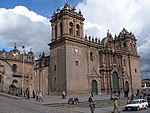 |
Cuzco | 1983 | 273; iii, iv (cultural) | Cuzco was the most important city of the Inca Empire. It was built by the Inca king Pachacutec in the 15th century. The city had special areas for religion and government. When the Spanish arrived in the 16th century, they built new churches and buildings on top of the old Inca ruins. |
| Historic Sanctuary of Machu Picchu | 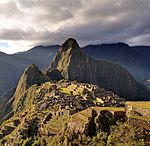 |
Cuzco | 1983 | 274; i, iii, vii, ix (mixed) | Machu Picchu is a stunning mountain city built around the mid-1400s. It sits high up, about 2,340 meters (7,677 feet) above sea level. The buildings and terraces are made from earthquake-resistant stone. About 1,200 people, mainly priests, women, and children, lived here. It was left empty before the Spanish arrived, possibly due to smallpox. |
| Chavín (Archaeological Site) | 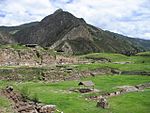 |
Ancash | 1985 | 330; iii (cultural) | The Chavín culture was an ancient civilization in the Andes mountains, from about 1500 to 300 BC. Chavín de Huantar was their main center. It has a complex of terraces and squares carved from rock. People believe the Chavín culture spread its influence through its religion and ideas, not by fighting. |
| Huascarán National Park | 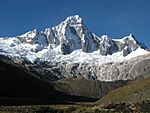 |
Ancash | 1985 | 333; vii, viii (natural) | This national park is in the Cordillera Blanca mountain range, home to Huascarán, Peru's tallest peak. It has amazing glaciers, deep valleys, and beautiful lakes. The park is also home to many unique animals. While no people live here, native llamas and alpacas graze in the lower areas. |
| Chan Chan Archaeological Zone |
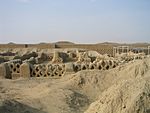 |
La Libertad | 1986 | 366; i, iii (cultural) | Chan Chan was the capital city of the Chimú culture. The Chimú kingdom grew along Peru's northern coast. The city is divided into nine walled areas, showing how society was organized. The Inca conquered the Chimú in 1470. Chan Chan was put on the "in danger" list right away because its adobe buildings are easily harmed by rain and erosion. |
| Manu National Park | 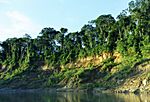 |
Cuzco | 1987 | 402; ix, x (natural) | This huge park covers about 1.5 million hectares (5,790 square miles). It stretches from 150 meters (492 feet) to 4,200 meters (13,780 feet) above sea level. Manu is home to an incredible variety of life, including 1,000 bird species, over 200 types of mammals, and more than 15,000 kinds of flowering plants. Rare animals like jaguars, giant otters, and giant armadillos live here. |
| Historic Centre of Lima | 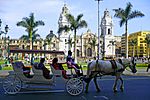 |
Lima Province | 1988 | 500; iv (cultural) | Lima was founded by Francisco Pizarro in 1535. For a long time, it was the most important city in Spanish South America. Its buildings mix local and European styles, like the beautiful Monastery of San Francisco. Many schools and universities, like San Marcos University (built in 1551), were also built here. |
| Rio Abiseo National Park |  |
San Martín | 1990 | 548; iii, vii, ix, x (mixed) | This park was created in 1983 to protect its amazing rainforest. It's home to many unique animals found nowhere else, like the yellow-tailed woolly monkey, which people once thought was extinct. The park is also important for its culture, as over 30 ancient Pre-Columbian sites have been found here since 1985. |
| Lines and Geoglyphs of Nazca and Pampas de Jumana |  |
Ica | 1994 | 700; i, iii, iv (cultural) | These huge designs in the Nazca Desert were made by the Nazca culture between 400 and 650 AD. They scratched lines into the ground to create images of animals like monkeys and hummingbirds, plants, and geometric shapes. These giant drawings are believed to have been used for religious ceremonies. |
| Historical Centre of the City of Arequipa | 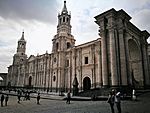 |
Arequipa | 2000 | 1016; i, iv (cultural) | Arequipa is mostly built from sillar, a white volcanic rock from the nearby El Misti volcano. The city's architecture is special because it mixes traditional local styles with building methods brought by European settlers. |
| Sacred City of Caral-Supe |  |
Lima | 2009 | 1269; ii, iii, iv (cultural) | This ancient site belonged to the Norte Chico civilization. Caral is one of the oldest known cities in the Americas. It has many monuments and pyramids. A quipu (a special knotted string record-keeping device) found here shows its influence on later Andean cultures. |
| Qhapaq Ñan, Andean Road System* | 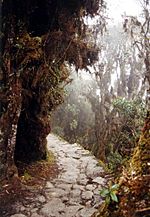 |
several regions | 2014 | 1459; ii, iii, iv, vi (cultural) | This site is a massive road system built by the Incas over many centuries. It spans more than 6,000 kilometers (3,700 miles) through different landscapes like coasts, rainforests, deserts, and mountains over 6,000 meters (19,685 feet) high. The system includes 273 important spots in six countries: Argentina, Bolivia, Chile, Colombia, Ecuador, and Peru. |
| Chankillo Archaeoastronomical Complex | 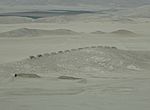 |
Ancash | 2021 | 1624; i, iv (cultural) | The Chankillo Complex is an ancient site from 250-200 BC. It has buildings that worked like a giant calendar. People used the sun to tell the dates throughout the year, including the longest and shortest days (solstices) and the days with equal day and night (equinoxes). It was very accurate, telling the date within one or two days. |
Sites Being Considered (Tentative List)
Besides the sites already on the World Heritage list, countries can suggest new places they think are important. These are put on a "tentative list." A site must be on this list before it can be officially nominated for the World Heritage list. As of 2018, Peru has eight sites on its tentative list.
| Site Name | Picture | Location (Region) | Year Added | UNESCO Criteria | What Makes It Special |
|---|---|---|---|---|---|
| Archaeological Complex of Pachacamac |  |
Lima | 1996 | (cultural) | This is an important ancient religious site near Lima. |
| Historic Center of the City of Trujillo | 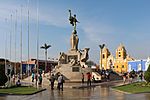 |
La Libertad | 1996 | (cultural) | This city center has beautiful historic buildings and monuments. |
| The Great Inka Trail: state transportation system originally named "Qhapac Ñan" |  |
several regions | 2001 | ii, iii, iv, v, vi (cultural) | This entry is specifically for Peru's part of the famous Inca road system. The larger "Qhapaq Ñan" system, shared with other countries, was added to the main list in 2014. |
| The Historic Centre of Cajamarca | 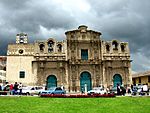 |
Cajamarca | 2002 | ii, iv (cultural) | This historic city center is known for its colonial architecture and important history. |
| Lake Titicaca | 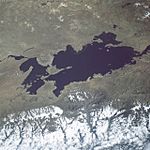 |
Puno | 2005 | ii, iii, v, vi, vii, x (mixed) | This large lake is important for its natural beauty, unique ecosystems, and the ancient cultures that lived around it. |
| Kuelap Archaeological Complex | 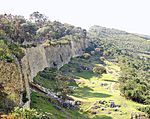 |
Amazonas | 2011 | iii, iv (cultural) | Kuelap is an ancient walled city built by the Chachapoyas people, high in the Andes. |
| Santa Bárbara mining complex | 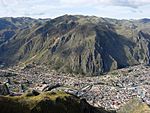 |
Huancavelica | 2017 | ii, iv (cultural) | This site includes old mines and related structures, showing the history of mining in Peru. |
| Salt Mines of Maras | 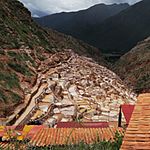 |
Cusco | 2019 | iii, v (cultural) | These ancient salt mines are a unique example of how people have harvested salt for centuries. |
| Baroque Temples of Collao | 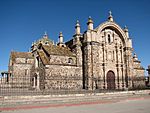 |
various regions | 2019 | ii, iv (cultural) | These are several beautiful Baroque-style temples found in the Collao region, showing European and local art styles. |
| Rural Temples of Cusco | 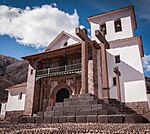 |
Cusco | 2019 | ii, iv (cultural) | These temples in the countryside around Cusco are important examples of religious architecture. |
See also
 In Spanish: Anexo:Patrimonio de la Humanidad en el Perú para niños
In Spanish: Anexo:Patrimonio de la Humanidad en el Perú para niños
- List of Intangible Cultural Heritage elements in Peru

